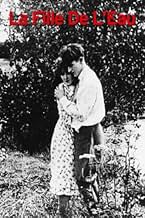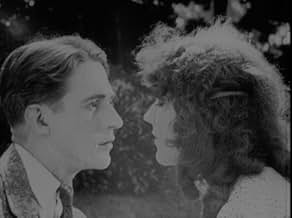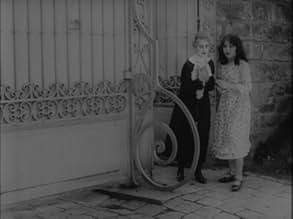CALIFICACIÓN DE IMDb
6.7/10
744
TU CALIFICACIÓN
Tras la muerte de su padre y tras haberse bebido su tío toda la herencia, Virginia se queda sola. Es aceptada por una familia de bohemios, pero una disputa entre los bohemios y los campesino... Leer todoTras la muerte de su padre y tras haberse bebido su tío toda la herencia, Virginia se queda sola. Es aceptada por una familia de bohemios, pero una disputa entre los bohemios y los campesinos la obliga a huir de la revuelta.Tras la muerte de su padre y tras haberse bebido su tío toda la herencia, Virginia se queda sola. Es aceptada por una familia de bohemios, pero una disputa entre los bohemios y los campesinos la obliga a huir de la revuelta.
- Dirección
- Guionista
- Elenco
- Dirección
- Guionista
- Todo el elenco y el equipo
- Producción, taquilla y más en IMDbPro
Opiniones destacadas
Admittedly made merely to exploit his wife Catherine Hessling's "photogenic" attributes, Jean Renoir's solo directorial debut already displays his trademark humanism and painterly eye while Hessling herself turns in a far more naturalistic performance here than she did in NANA (1926).
The plot is simple and melodramatic: Hessling loses her father, is abused by her brutish uncle (possibly inspired by Griffith's BROKEN BLOSSOMS [1919]), falls in with crooked gypsies (who ultimately incur the wrath of the people and have their caravan burned to the ground), is taken in by a wealthy family but is caught stealing for her uncle's sake until the latter gets his come-uppance and the girl is engaged to her employer's young son. The accompanying organ score is effectively evocative to begin with but, eventually, it takes a tediously avant-gardist turn.
The film's barge opening anticipates Jean Vigo's L'ATALANTE (1934) and the search at sea, F.W. Murnau's SUNRISE (1927); there is also some remarkably fast cutting throughout, a style which Renoir would largely forsake in his subsequent work. The highlight of WHIRPLOOL OF FATE, however, is undoubtedly an amazing dream sequence which, uncharacteristically for the director, is heavily reliant on optical effects and camera technique; incidentally, the two shorts I followed it with on Lionsgate 3-Disc "Jean Renoir's Collector's Edition" proved similarly experimental.
The plot is simple and melodramatic: Hessling loses her father, is abused by her brutish uncle (possibly inspired by Griffith's BROKEN BLOSSOMS [1919]), falls in with crooked gypsies (who ultimately incur the wrath of the people and have their caravan burned to the ground), is taken in by a wealthy family but is caught stealing for her uncle's sake until the latter gets his come-uppance and the girl is engaged to her employer's young son. The accompanying organ score is effectively evocative to begin with but, eventually, it takes a tediously avant-gardist turn.
The film's barge opening anticipates Jean Vigo's L'ATALANTE (1934) and the search at sea, F.W. Murnau's SUNRISE (1927); there is also some remarkably fast cutting throughout, a style which Renoir would largely forsake in his subsequent work. The highlight of WHIRPLOOL OF FATE, however, is undoubtedly an amazing dream sequence which, uncharacteristically for the director, is heavily reliant on optical effects and camera technique; incidentally, the two shorts I followed it with on Lionsgate 3-Disc "Jean Renoir's Collector's Edition" proved similarly experimental.
This will mostly seem outdated now. A silent melodrama about a young destitute girl in the French countryside trapped between men who desire her, and on the other hand by her efforts to comply or reciprocate. Various bargains that have to do with money as the more or less thinly veiled metaphor for sex.
But there is a dream sequence here that, as so often with these silent dreams, I urge you to see. It's about the girl transmuting in her feverish mind these barely comprehensible forces that threaten the virgin soul into images that will make sense; so an imaginative flight, a sensual, delirius game of hide-and-seek where the coarse, violent men haunt her down, where a piece of rope transforms into the snake of mischievous desire, a point-of-view rushing towards a door and the light outside, and finally the man who can protect her shown, quite literally, as a champion on his white horse galloping across the skies.
The overwhelming experience is so perfectly about the distorted imprint of the world. This should be seen next to the best moments in Epstein. There is shadow here cast by the eye in motion, emotional or otherwise.
Another note that intrigues, a blemish in the perfect picture of her well-to-do benefactor. His parents are shown at one point hastily leaving for Algiers on account of business; what was probably meant innocently at the time, now can only leave us wondering at his source of wealth.
But there is a dream sequence here that, as so often with these silent dreams, I urge you to see. It's about the girl transmuting in her feverish mind these barely comprehensible forces that threaten the virgin soul into images that will make sense; so an imaginative flight, a sensual, delirius game of hide-and-seek where the coarse, violent men haunt her down, where a piece of rope transforms into the snake of mischievous desire, a point-of-view rushing towards a door and the light outside, and finally the man who can protect her shown, quite literally, as a champion on his white horse galloping across the skies.
The overwhelming experience is so perfectly about the distorted imprint of the world. This should be seen next to the best moments in Epstein. There is shadow here cast by the eye in motion, emotional or otherwise.
Another note that intrigues, a blemish in the perfect picture of her well-to-do benefactor. His parents are shown at one point hastily leaving for Algiers on account of business; what was probably meant innocently at the time, now can only leave us wondering at his source of wealth.
To try to find some of the seeds which produced Renoir's masterpieces of the thirties is splitting hairs.All we can say is that it shows Renoir's taste for nature ,rivers,country landscapes.
The heroine called Gudule (the name has become completely ludicrous in today's France ;no one is called Gudule anymore)is played by Renoir's favorite actress of the silent era ,Catherine Hessling.Her fate is worthy of Hugo's "les miserables" :mistreated by a wicked lecherous uncle ,taken in by a poacher and his mum, left in the cold and the rain...And finally she finds love :a nice young man falls for her and marries her.His background is very bourgeois ,but the parents do not seem to bother.That is to say we are far from "Boudu Sauvé des Eaux" ,"La Chienne" and even "Une Partie de Campagne" .
Best moment: the heroine's nightmare;people who know well Renoir's silent era will notice the similarities between this sequence and that of "La Petite Fille aux Allumettes" where the little match girl and her attentive escort go for a horse ride in the sky.The comparison stops here for " La Fille de l'Eau' is inferior to the Andersen adaptation.
Actually the main influence is DW Griffith but then again Hessling is not
Lilian Gish.
For Renoir's fans.The others might find it a bit obsolete.
The heroine called Gudule (the name has become completely ludicrous in today's France ;no one is called Gudule anymore)is played by Renoir's favorite actress of the silent era ,Catherine Hessling.Her fate is worthy of Hugo's "les miserables" :mistreated by a wicked lecherous uncle ,taken in by a poacher and his mum, left in the cold and the rain...And finally she finds love :a nice young man falls for her and marries her.His background is very bourgeois ,but the parents do not seem to bother.That is to say we are far from "Boudu Sauvé des Eaux" ,"La Chienne" and even "Une Partie de Campagne" .
Best moment: the heroine's nightmare;people who know well Renoir's silent era will notice the similarities between this sequence and that of "La Petite Fille aux Allumettes" where the little match girl and her attentive escort go for a horse ride in the sky.The comparison stops here for " La Fille de l'Eau' is inferior to the Andersen adaptation.
Actually the main influence is DW Griffith but then again Hessling is not
Lilian Gish.
For Renoir's fans.The others might find it a bit obsolete.
"La Fille De L'Eau" is Jean Renoir's first film; Renoir is very well recognized by the longhaired generation, due especially to his sound period; this is a youthful film, and we all know how bold the longhaired are during their early lives..
A melodramatic air can be noted in the film's storyline; it tells the story of Damen Gudule (characterized by the director's muse, Catherine Hessling) a girl who goes through many and varied misfortunes, the sad details of which this aristocrat will enumerate.
Gudule works with her father and uncle in a scow, up and down river (first disgrace: a girl working, and to makes matters worse, in such a vulgar place); when her father accidentally drowns, her uncle tries to abuse the poor little orphan.
Weary of this harassment, Gudule runs away and leaves the scow behind, uncle included, and joins a group of low life people (the lady reads cards and the boy is a petty thief, occupations not very commendable especially the lady's one); due to Gudule's unlimited charms she soon attracts another undesirable suitor but the petty thief rescues her honor. When the little orphan rejects the young pursuer's further indecent proposals, the rejected scoundrel, helped by some neighbors, decides to burn the wagon of her new family.
Alone, without wagon or family (they ran away during the fire), the tragic Gudule's destiny becomes bleaker still with the reappearance of her uncle, who asks her to finance his pitiful life. The hapless young woman then is instructed to rob the house where she is now working and where she has attracted the young Master (another mishap; the intimacy between different social classes)
The young Master, when he discovers that his dearly beloved has been extorted by her uncle, decides they must get rid of such an unrepresentable family member and defeats the evil uncle in a tough fight; Gudule's new heartthrob takes the young woman with all his family to Algeria (as though poor Gudule hasn't suffered enough; now she must endure the tacky holiday destination chosen by her lover)
In spite of the film's imperfections and undefined style, this German count was impressed by Gudule's dream sequence with its obvious surrealist influence, it fascinates the spectator with its strange and suggestive shots; it is mainly because of this that the film deserves to be seen.
And now, if you allow me, I must temporarily take my leave due to the fact that this Count needs to called to order too, some unrepresentable family members.
A melodramatic air can be noted in the film's storyline; it tells the story of Damen Gudule (characterized by the director's muse, Catherine Hessling) a girl who goes through many and varied misfortunes, the sad details of which this aristocrat will enumerate.
Gudule works with her father and uncle in a scow, up and down river (first disgrace: a girl working, and to makes matters worse, in such a vulgar place); when her father accidentally drowns, her uncle tries to abuse the poor little orphan.
Weary of this harassment, Gudule runs away and leaves the scow behind, uncle included, and joins a group of low life people (the lady reads cards and the boy is a petty thief, occupations not very commendable especially the lady's one); due to Gudule's unlimited charms she soon attracts another undesirable suitor but the petty thief rescues her honor. When the little orphan rejects the young pursuer's further indecent proposals, the rejected scoundrel, helped by some neighbors, decides to burn the wagon of her new family.
Alone, without wagon or family (they ran away during the fire), the tragic Gudule's destiny becomes bleaker still with the reappearance of her uncle, who asks her to finance his pitiful life. The hapless young woman then is instructed to rob the house where she is now working and where she has attracted the young Master (another mishap; the intimacy between different social classes)
The young Master, when he discovers that his dearly beloved has been extorted by her uncle, decides they must get rid of such an unrepresentable family member and defeats the evil uncle in a tough fight; Gudule's new heartthrob takes the young woman with all his family to Algeria (as though poor Gudule hasn't suffered enough; now she must endure the tacky holiday destination chosen by her lover)
In spite of the film's imperfections and undefined style, this German count was impressed by Gudule's dream sequence with its obvious surrealist influence, it fascinates the spectator with its strange and suggestive shots; it is mainly because of this that the film deserves to be seen.
And now, if you allow me, I must temporarily take my leave due to the fact that this Count needs to called to order too, some unrepresentable family members.
8RNQ
A complex and sympathetic narrative about a young woman that begins with her working on a river barge with her father and her uncle and follows her through difficult circumstances after her father dies, exploited but resourceful, even using petty crime, particularly in the company of a scampish boy. There's something Pickfordesque about Catherine Hessling (who became Mme. Renoir), and a touch of D. W. Griffith in her occasional hanky-winding, but Renoir is not as sentimental. There's a dream sequence as good as Hitchcock decades later, night scenes (a haystack on fire), and observations about the ways of the well-born that are a start on the way to La Règle du jeu.
¿Sabías que…?
- TriviaCharlotte Clasis's debut.
- ConexionesEdited into Spisok korabley (2008)
Selecciones populares
Inicia sesión para calificar y agrega a la lista de videos para obtener recomendaciones personalizadas
Detalles
- Tiempo de ejecución1 hora 11 minutos
- Color
- Mezcla de sonido
- Relación de aspecto
- 1.33 : 1
Contribuir a esta página
Sugiere una edición o agrega el contenido que falta

Principales brechas de datos
What is the English language plot outline for La hija del agua (1925)?
Responda






















